初中语法方位介词
- 格式:doc
- 大小:37.00 KB
- 文档页数:8
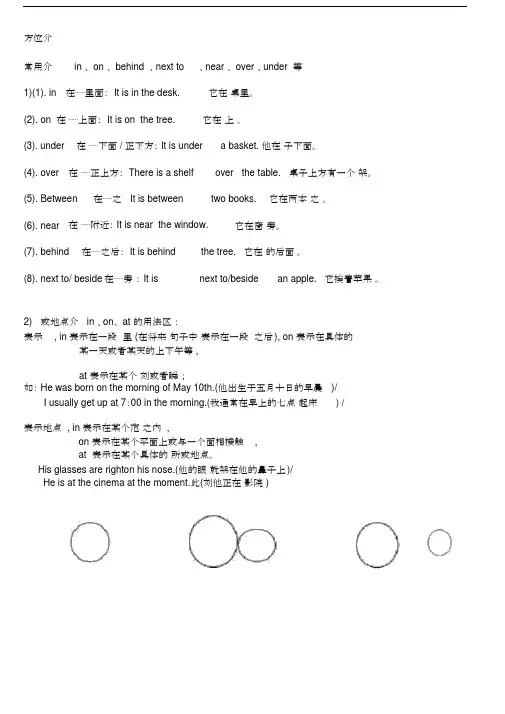
方位介常用介in 、 on 、 behind 、next to 、near 、 over 、under 等1)(1). in 在⋯⋯里面: It is in the desk. 它在桌里。
(2). on 在⋯⋯上面: It is on the tree. 它在上。
(3). under 在⋯⋯下面 / 正下方: It is under a basket. 他在子下面。
(4). over 在⋯⋯正上方: There is a shelf over the table. 桌子上方有一个架。
(5). Between 在⋯⋯之 It is between two books. 它在两本之。
(6). near 在⋯⋯附近: It is near the window. 它在窗旁。
(7). behind 在⋯⋯之后: It is behind the tree. 它在的后面。
(8). next to/ beside在⋯⋯旁:It is next to/beside an apple. 它挨着苹果。
2)或地点介 in 、on、 at 的用法区:表示 , in 表示在一段里 (在将来句子中表示在一段之后), on 表示在具体的某一天或者某天的上下午等 ,at 表示在某个刻或者瞬;如: He was born on the morning of May 10th.(他出生于五月十日的早晨)/I usually get up at 7:00 in the morning.(我通常在早上的七点起床) /表示地点 , in 表示在某个范之内 ,on 表示在某个平面上或与一个面相接触,at 表示在某个具体的所或地点。
His glasses are righton his nose.(他的眼就架在他的鼻子上)/He is at the cinema at the moment.此(刻他正在影院 )B A B A B AB 在 A 里——用in A 和B 相(接壤)——用on A 和B 不相(不接壤)——用to3) in front of “在⋯之前”(范外)in the front of 表示“在⋯的前部”(范内)演1. The United States is ____ the south of Canada and ___ the east of Japan.A. to; inB. on; toC. in; besideD. at; on2 . Japan lies____ the east of China.A. on B/ to C. in D. with3. Jiangsu is___ the east of China, but Japan is ___ the east of China.A. to; inB. in; to .C. on; toD. to; on4.There are some trees_________ the classroomThere is a blackboard ____________ the classroom.5.—Look, there are many apples ______ the tree.—Yes. And a boy is picking apples ______ the tree now.A. in; onB. on; inC. in; inD. on; on6.When did you arrive ______school this morning?A. inB. atC. toD. with。

初中语法之方位介词用法如:The book is on the table.书在桌子上。
4.to表示"到达某个地方",强调目的地,不强调是否接壤。
如:We are going to the park.我们要去公园。
5.XXX表示"在。
上方",不强调是否垂直,与below相对。
如:The sun is above the clouds.太阳在云层上方。
6.over表示"在。
上方",强调垂直的上方,与under相对,但over与物体有一定的空间,不直接接触。
如:The plane is flying over the city.飞机在城市上方飞行。
7.on表示"在。
上面",并与之接触。
如:The cup is on the table.杯子在桌子上。
8.under表示"在。
下方",正下方。
如:The cat is under the bed.猫在床下。
9.below表示"在。
下面",不一定在正下方。
如:Please write your name below the line.请在线下方写下你的名字。
XXX is summer。
I love the XXX。
I also like to go XXX。
Summer is a great time to travel and see new things.XXX activities。
I also enjoy reading during the summer。
I like to sit outside and read a book in the sunshine。
It's a great way to relax and unwind。
I usually choose light and easy reads for the summer。


初中英语知识点归纳介词的用法介词是连接词与词之间,短语与短语之间,在句中表示方向、关系、时间、原因等意义的词语。
在英语中,介词的用法非常丰富多样,掌握好介词的用法,对于学习英语有着重要的意义。
下面将对初中英语中常见的介词用法进行归纳介绍。
一、表示方向、位置和距离的介词1. 在(in):在某个地方或物体内部2. 在(on):在某个平面或表面上3. 在(at):在某个地点4. 在(over):位于之上,不接触5. 在(under):位于之下,不接触6. 在(between):在两个事物之间7. 在(behind):在某物之后8. 在(in front of):在某物之前9. 在(near):在附近10. 在(around):在周围二、表示时间的介词1. 在(at):在某个具体时间点2. 在(in):在某个时间段3. 在(on):在某个具体日期三、表示原因的介词1. 因为(of):表示原因、缘故2. 由于(because of):表示原因、由于四、表示目的、用途和方式的介词1. 为了(in order to):表示目的2. 以便(in order that):表示目的3. 用(with):表示使用的手段或工具4. 通过(by):表示方式、方法5. 以(for):表示目的五、表示比较的介词1. 比较起见(than):表示比较的对象2. 和(with):与某人或某物在一起六、其它常见的介词1. 关于(about):表示涉及某一话题2. 靠(by):表示接近某人或某物3. 经过(through):表示通过某地或某事4. 编写(at):表示在某地工作或活动5. 因(as):表示角色、身份6. 例如(for example):表示举例7. 包括(including):表示包含某物以上是初中英语中常见的介词用法的归纳总结。
熟练掌握这些介词的用法,对于构建正确的句子和语法结构非常重要。
希望能对你的学习有所帮助。
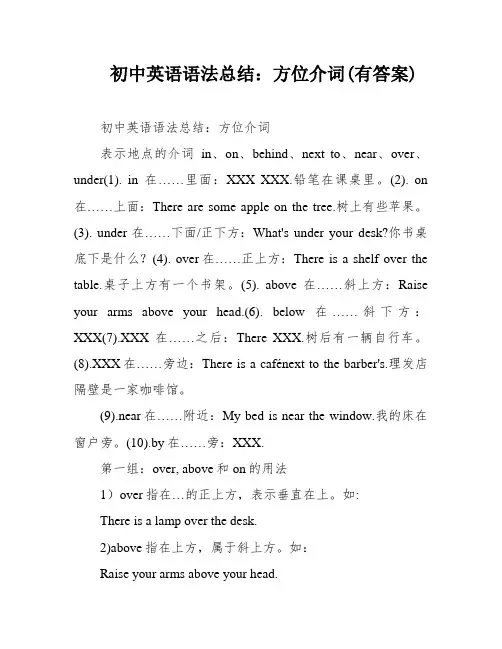
初中英语语法总结:方位介词(有答案)初中英语语法总结:方位介词表示地点的介词in、on、behind、next to、near、over、under(1). in在……里面:XXX XXX.铅笔在课桌里。
(2). on 在……上面:There are some apple on the tree.树上有些苹果。
(3). under在……下面/正下方:What's under your desk?你书桌底下是什么?(4). over在……正上方:There is a shelf over the table.桌子上方有一个书架。
(5). above在……斜上方:Raise your arms above your head.(6). below在……斜下方:XXX(7).XXX在……之后:There XXX.树后有一辆自行车。
(8).XXX在……旁边:There is a cafénext to the barber's.理发店隔壁是一家咖啡馆。
(9).near在……附近:My bed is near the window.我的床在窗户旁。
(10).by在……旁:XXX.第一组:over, above和on的用法1)over指在…的正上方,表示垂直在上。
如:There is a lamp over the desk.2)above指在上方,属于斜上方。
如:Raise your arms above your head.3)on指在上面,表示两物体接触。
如:There is a cup on the table.第二组:under / below的用法:1) under在……上面/正下方:What's under your desk?2) below在……斜下方:XXX.操演:() 1 The boat is passing___ the bridge.A. XXX() 2 Two planes are flying___ the city.A. XXX, below() 3 We can see a river running to the east____ the XXX() 4 Do you see the kite ___ the building.A. XXX参考谜底C B B D第三组:in和on透露表现“在……上”门一类——镶嵌在墙里的,用in书画一类——挂在墙面上的,用on() 1 He put up a map ___ the back wall because there was a hole ___ it.A. on; onB. at; inC. on; inD. on; at() 2 There is a door___ the wall.A. XXX() 3 Any man ___ eyes______ his head can see that he'XXX.A. with; onB. with; inC. on; withD. in; with鸟一类落在树上的,用in;XXX一类长在树上的,用on() 1 There are some birds singing___ the trees.A. XXX() 2 There are so many apples___ that tree.A. inB, XXX第四组:XXX表示“接壤”第四组:XXX表示“接壤”BABAB在A里——用inA和B相邻(接壤)——用onABA和B不相邻(不接壤)——用to练() 1 The United States is ____ the south of Canada and ___ the east of Japan.A. to; inB. on; toC. in; besideD. at; on() 2 The man stood ____the window, XXX() 3 Japan lies____ the east of China.A. XXX参考答案B B B B第五组:at, in表示“在……”1)at透露表现较小的地址。
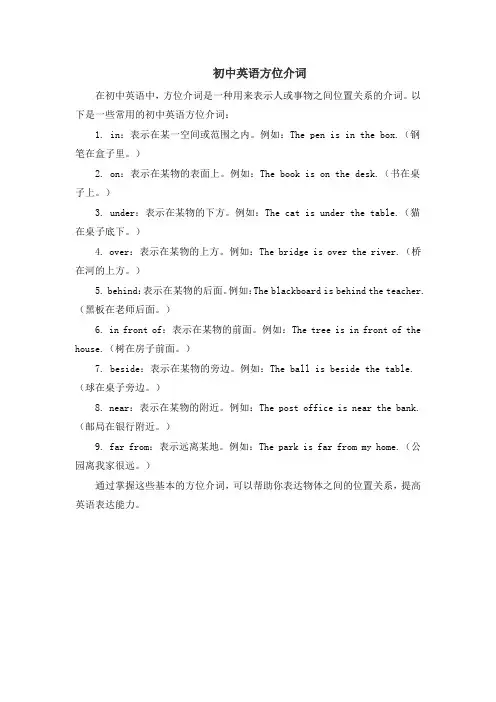
初中英语方位介词在初中英语中,方位介词是一种用来表示人或事物之间位置关系的介词。
以下是一些常用的初中英语方位介词:1. in:表示在某一空间或范围之内。
例如:The pen is in the box.(钢笔在盒子里。
)2. on:表示在某物的表面上。
例如:The book is on the desk.(书在桌子上。
)3. under:表示在某物的下方。
例如:The cat is under the table.(猫在桌子底下。
)4. over:表示在某物的上方。
例如:The bridge is over the river.(桥在河的上方。
)5. behind:表示在某物的后面。
例如:The blackboard is behind the teacher.(黑板在老师后面。
)6. in front of:表示在某物的前面。
例如:The tree is in front of the house.(树在房子前面。
)7. beside:表示在某物的旁边。
例如:The ball is beside the table.(球在桌子旁边。
)8. near:表示在某物的附近。
例如:The post office is near the bank.(邮局在银行附近。
)9. far from:表示远离某地。
例如:The park is far from my home.(公园离我家很远。
)通过掌握这些基本的方位介词,可以帮助你表达物体之间的位置关系,提高英语表达能力。
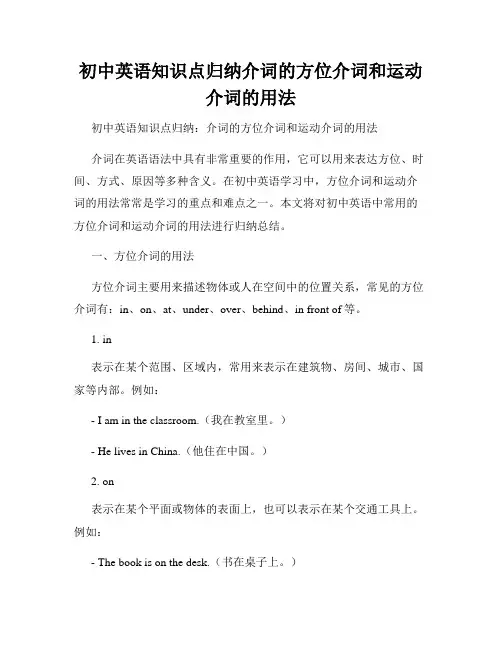
初中英语知识点归纳介词的方位介词和运动介词的用法初中英语知识点归纳:介词的方位介词和运动介词的用法介词在英语语法中具有非常重要的作用,它可以用来表达方位、时间、方式、原因等多种含义。
在初中英语学习中,方位介词和运动介词的用法常常是学习的重点和难点之一。
本文将对初中英语中常用的方位介词和运动介词的用法进行归纳总结。
一、方位介词的用法方位介词主要用来描述物体或人在空间中的位置关系,常见的方位介词有:in、on、at、under、over、behind、in front of等。
1. in表示在某个范围、区域内,常用来表示在建筑物、房间、城市、国家等内部。
例如:- I am in the classroom.(我在教室里。
)- He lives in China.(他住在中国。
)2. on表示在某个平面或物体的表面上,也可以表示在某个交通工具上。
例如:- The book is on the desk.(书在桌子上。
)- We are on the bus.(我们在公交车上。
)3. at表示在某个具体的地点或时间上。
例如:- She is waiting for me at the bus stop.(她在公交车站等我。
)- We often have dinner at home.(我们经常在家吃晚饭。
)4. under表示在某物或某个位置的下方。
例如:- The cat is under the table.(猫在桌子下。
)- The book is under the bed.(书在床下。
)5. over表示在某物或某个位置的上方。
例如:- The bird is flying over the house.(鸟在房子上方飞翔。
)- The blanket is over the child.(毯子在孩子上面。
)6. behind表示在某物或某个位置的后方。
例如:- The tree is behind the house.(树在房子后面。
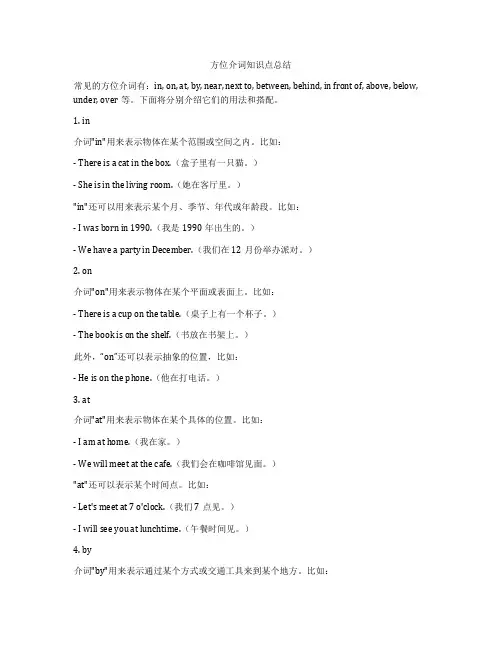
方位介词知识点总结常见的方位介词有:in, on, at, by, near, next to, between, behind, in front of, above, below, under, over等。
下面将分别介绍它们的用法和搭配。
1. in介词"in"用来表示物体在某个范围或空间之内。
比如:- There is a cat in the box.(盒子里有一只猫。
)- She is in the living room.(她在客厅里。
)"in"还可以用来表示某个月、季节、年代或年龄段。
比如:- I was born in 1990.(我是1990年出生的。
)- We have a party in December.(我们在12月份举办派对。
)2. on介词"on"用来表示物体在某个平面或表面上。
比如:- There is a cup on the table.(桌子上有一个杯子。
)- The book is on the shelf.(书放在书架上。
)此外,“on”还可以表示抽象的位置,比如:- He is on the phone.(他在打电话。
)3. at介词"at"用来表示物体在某个具体的位置。
比如:- I am at home.(我在家。
)- We will meet at the cafe.(我们会在咖啡馆见面。
)"at"还可以表示某个时间点。
比如:- Let's meet at 7 o'clock.(我们7点见。
)- I will see you at lunchtime.(午餐时间见。
)4. by介词"by"用来表示通过某个方式或交通工具来到某个地方。
比如:- He came by bus.(他乘公交车来了。
)- We can go by train.(我们可以坐火车去。
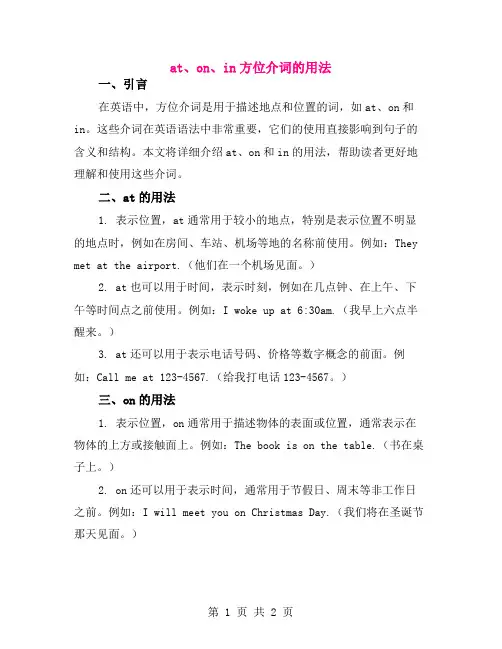
at、on、in方位介词的用法一、引言在英语中,方位介词是用于描述地点和位置的词,如at、on和in。
这些介词在英语语法中非常重要,它们的使用直接影响到句子的含义和结构。
本文将详细介绍at、on和in的用法,帮助读者更好地理解和使用这些介词。
二、at的用法1. 表示位置,at通常用于较小的地点,特别是表示位置不明显的地点时,例如在房间、车站、机场等地的名称前使用。
例如:They met at the airport.(他们在一个机场见面。
)2. at也可以用于时间,表示时刻,例如在几点钟、在上午、下午等时间点之前使用。
例如:I woke up at 6:30am.(我早上六点半醒来。
)3. at还可以用于表示电话号码、价格等数字概念的前面。
例如:Call me at 123-4567.(给我打电话123-4567。
)三、on的用法1. 表示位置,on通常用于描述物体的表面或位置,通常表示在物体的上方或接触面上。
例如:The book is on the table.(书在桌子上。
)2. on还可以用于表示时间,通常用于节假日、周末等非工作日之前。
例如:I will meet you on Christmas Day.(我们将在圣诞节那天见面。
)3. on还可以用于表示电视节目、广播节目等的播放时间。
例如:Please turn on the TV and watch the news at 7pm.(请打开电视在晚上七点观看新闻。
)四、in的用法1. 表示位置,in通常用于描述较大的地方或物体内部,例如房间、教室、学校、建筑物等场所的前面或里面。
例如:We meet in the classroom every day.(我们每天在教室见面。
)2. in还可以用于表示衣服或物体的尺寸或大小。
例如:She wears a dress in size 8.(她穿着8号的连衣裙。
)3. in也可以用于时间和年代的表述中,通常用于具体的日期或年份之前。
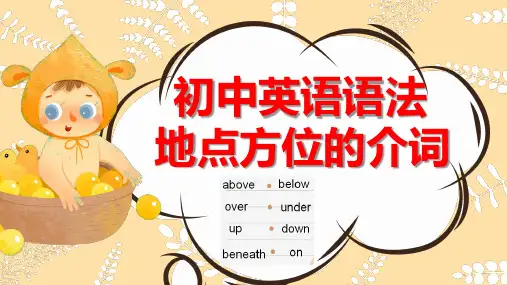
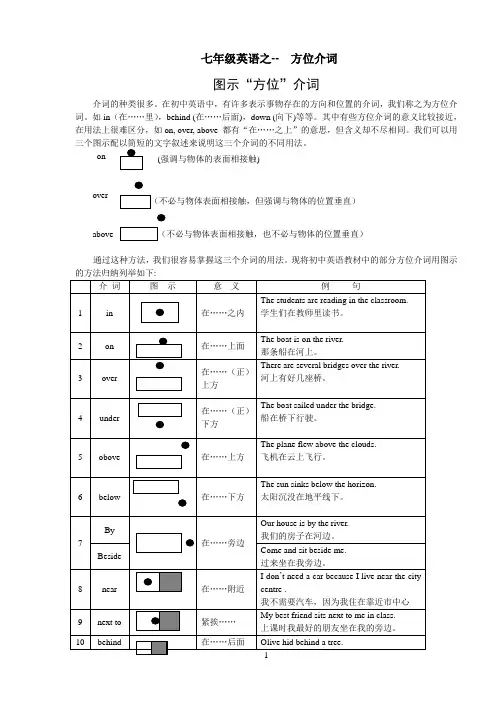
七年级英语之-- 方位介词
图示“方位”介词
介词的种类很多。
在初中英语中,有许多表示事物存在的方向和位置的介词,我们称之为方位介词。
如in (在……里),behind (在……后面),down (向下)等等。
其中有些方位介词的意义比较接近,在用法上很难区分,如on, over, above 都有“在……之上”的意思,但含义却不尽相同。
我们可以用三个图示配以简短的文字叙述来说明这三个介词的不同用法。
on
over
above
通过这种方法,我们很容易掌握这三个介词的用法。
现将初中英语教材中的部分方位介词用图示(强调与物体的表面相接触)。
(完整word版)方位介词初中英语亲爱的读者:本文内容由我和我的同事精心收集整理后编辑发布到文库,发布之前我们对文中内容进行详细的校对,但难免会有错误的地方,如果有错误的地方请您评论区留言,我们予以纠正,如果本文档对您有帮助,请您下载收藏以便随时调用。
下面是本文详细内容。
最后最您生活愉快 ~O(∩_∩)O ~表示位置的介词有:at, in, by, near, between, under表示方向的介词有:to, into, out, out of, across, along, through1 at表示在某地点,强调在某个位置点例:I met her at the school gate this morning. 我今天早上在校门口遇见了她。
at也用于街道号码前例:She lives at 78 Nanjing Road. 她住在南京路78号。
She lives on Nanjing Road. 她住在南京路。
(街道前无号码时用on)She lives in Queen Street. 她住在女王街。
(住在某大街用in)2 in表示“在某区域内,在一个空间的内部,在……里面”例:She was born in Nanjing. 她生于南京。
提示:两个地名连用时,小的用at,大的用in.例:He arrived at London in England last week. 他上周到达英国伦敦。
They will meet at Washington in America. 他们将在美国华盛顿会面。
3 on表示“在……上”,并与之相接触例:He put the dictionary on the desk. 他把词典放在桌子上。
比较英国英语和美国英语的不同介词用法:在路上on the road (美)in the road (英)在街上on the street (美)in the street (英)在周末on the weekend (美)at the weekend (英)在这个队on the team (美)in the team (英)4 under和below表示“在……的正下方”,指垂直上下。
方位介词用法总结方位介词是一类用于表示地点、位置、方向等概念的介词。
在英语中,常见的方位介词有in、on、at、under、below、above、over、to、from、between、among等。
它们的不同用法和意义有所区别,下面对这些方位介词的常见用法进行总结和解释。
1. in:表示"在……之内",通常用于地点、国家、城市等概念上,例如:- He is in the room.(他在房间里。
)- She lives in London.(她住在伦敦。
)2. on:表示"在……之上",可以用于表示在物体表面、建筑物上、车辆上等地方,例如:- The book is on the table.(那本书在桌子上。
)- I saw him on the bus.(我在公交车上见到他。
)3. at:表示"在……处",可以用于点、地方或事件等的描述上,例如:- He is waiting for you at the bus stop.(他在公交车站等你。
)- We had dinner at a fancy restaurant last night.(昨晚我们在一家高档餐厅吃饭。
)4. under:表示"在……之下",可以用于表示物体的位置或遮蔽物下等情况,例如:- The cat is sleeping under the table.(猫睡在桌子下面。
)- The book is under the bed.(书在床下。
)5. below:表示"在……以下",可以用于比较高度、水平或等级等的描述上,例如:- The temperature dropped below freezing last night.(昨晚气温降到了冰点以下。
)- He ranks below his brother in the class.(他在班里的排名在他弟弟之下。
初一英语方位介词一、方位介词1、at表示\"在、、、、、、处\",一般指较小的比较具体的地点。
He isnt at school、 He is at home、2、 in表示\"在、、、、、、内部;在、、、、、、里面\"的意思。
W hat is in the box? 盒子里有什么?3、 on表示\"在某物的上面\",但两者互相接触。
My books are on that table、我的书在那张桌子上。
4、above在、、、、上方。
指两者既不垂直也不接触(反义词below)Many birds are flying above the woods、许多鸟在树林上飞。
5、 under表示"在某物垂直的正下方",两者之间不接触。
My cat is under my chair、我的猫在我的椅子下。
6、 behind表示"在某物体的后面"。
T he boy is behind the door、男孩在门后。
7 in front of表示\"在、、、、、、的前面\",正好与behind相反。
如:There are some big trees in front of our classroom、我们教室前面有几棵大树。
8、 near表示\"在某物体的附近\",意为"接近、靠近。
T he ball is near the door、球在门旁边。
介词in, on, under, behind是表示静态位置的介词。
二、常见方位介词短语(一)、由介词in构成的方位介词短语1、in the front 在前面2、in the front row 在前排3、in the back row 在后排4、in the third row 在第三排5、in front of、、、在、、、前面(范围之外)6、in the front of、、、在、、、前部(范围之内)7、in the middle在中间8、in the street在街上9、in the middle of、、、在中间10、in the tree在树上(指飞鸟等外来物)(二)、由介词at构成的方位介词短语1、at the front of、、、在、、、所在范围的前一部分2、at the back of、、、在、、、所在范围的后一部分3、at the foot of、、、在、、、脚下4、at the top of、、、在、、、顶部5、at the end of、、、在、、、尽头6、at the head of、、、在、、、前头7、at the(school)gate在(校)门口8、at the station 在车站9、at No、2 Chang’an Road在长安路2号10、at my uncle’s 在我叔叔家11、at home在家12、at the doctor’s在医务室/在诊所(三)、由介词on构成的方位介词短语1、on the right/left在右(左)边2、on one’s right/left在某人的右(左)边3、on the desk/table在课桌/桌上4、on the right-hand/left-hand side在右/左手边5、on the blackboard在黑板上6、on/in the wall在墙上/里7、on the paper在纸上8、on the tree在树上(指树上长的,结的东西)三、其它介词构成的方位介词短语1、next to靠近/贴近2、beside the desk在课桌旁3、behind the door在门后4、under the bed在床下5、near the window靠近窗户6、outside the gate在门外。
介词总结归纳初中介词是英语语法中的一个重要部分,用来表示名词、代词与其他词之间的关系。
在初中阶段,学生需要掌握并正确运用各种介词。
下面将对初中阶段常见的介词进行总结归纳。
一、表示位置或方向的介词:1. in:在某个范围、地点或建筑物内。
例:I am studying in the classroom.2. on:在某个平面或物体的表面。
例:The book is on the table.3. at:在某个特定的地点或事件上。
例:He is waiting at the bus stop.4. under:在某物的下面。
例:The cat is under the table.5. above:在某物的上面。
例:The bird is flying above the tree.6. behind:在某物的后面。
例:The car is parked behind the house.7. in front of:在某物的前面。
例:The children are playing in front of the school. 8. between:在两个物体或位置之间。
例:The river flows between the two mountains.9. among:在三个或三个以上的物体或位置之间。
例:He found his friends among the crowd.二、表示时间的介词:1. at:在特定的时间点。
例:The movie starts at 7 o'clock.2. on:在某一天、日期或节日。
例:We have a holiday on Sunday.3. in:在某个时间段或季节。
例:She was born in October.4. during:在某个时间段内。
例:I read a book during the summer vacation.5. for:表示持续时间。
初中英语语法总结:方位介词(有答案)A。
XXX初中英语语法总结:方位介词方位介词用于描述物体或人在空间中的位置关系,常见的有in、on、behind、next to、near、over、under等。
1.in表示在某个物体内部,如XXX可以改为XXX XXX XXX.2.on表示在某个物体的表面,如There are some apples on the tree.可以改为The apples are on the surface of the tree.3.under表示在某个物体的下面或正下方,如What's under your desk?可以改为XXX?4.over表示在某个物体的正上方,如There is a shelf over the table.可以改为There is a shelf above the table.5.XXX表示在某个物体的斜上方,如Raise your arms above your head.可以改为Lift your arms at an angle above your head.6.below表示在某个物体的斜下方,如XXX可以改为XXX.7.XXX表示在某个物体的后面,如There XXX.可以改为There is a bike at the back of the tree.8.XXX表示在某个物体的旁边,如There is a café next to the barber's.可以改为There is a café beside the barber's.9.near表示在某个物体的附近,如My bed is near the window.可以改为My bed is close to the window.XXX表示在某个物体的旁边,如He was XXX.可以改为He was sitting next to the window.练:1.XXX passing ___ the bridge.A。
20个常用英语表方位介词常用的20个英语表方位介词有:in、on、at、under、over、above、below、in front of、behind、along、across、around、near、next to、by、beside、towards、inside、outside、to等等。
1、in:在……内部;在……里面的意思;What is in the box?盒子里有什么?2、on:在某物的上面,两者互相接触;My books are on that table.我的书在那张桌子上。
3、at:在……处,一般指较小的比较具体的地点;He isn't at school.He is at home.他不在学校,他在家。
4、under:表示在某物垂直的正下方,两者之间不接触;My cat is under my chair.我的猫在我的椅子下。
5、over:一种垂直悬空的上下关系,即“在正上方”,是under的相对反义词;Is there any bridge over the river?6、above: 在......上方,相对于另一者在上方7、below: 在......上方,相对于另一者在上方,是above的相对反义词;8、in front of:在……的前面,正好与behind相反;There are some big trees in front of our classroom. 我们教室前面有几棵大树。
9、behind:在某物体的后面。
The broom is behind the door.笤帚在门后。
10、along:沿着……,顺着……I'm walking along the river.我正沿河而行。
11、across:从一边到另一边,在……那边。
There are many trees across the river.河对岸有很多树。
12、around:“围绕,绕着”The house is built around a central courtyard.这房子是围绕着中央的庭院而建的。
二、表示地点的介词in、on、behind、next to、near、over、under(1)、in在……里面: The pencil is in the desk、铅笔在课桌里。
(2)、on在……上面: There are some apple on the tree、树上有些苹果。
(3)、under在……下面/正下方:What's under your desk? 您书桌底下就是什么?(4)、over在……正上方: There is a shelf over the table、桌子上方有一个书架。
(5)、above 在……斜上方:Raise your arms above your head、(6)、below 在……斜下方:Her skirt came below her knees、(7)、behind在……之后: There is a bike behind the tree、树后有一辆自行车。
(8)、next to在……旁边:There is a café next to the barber's、理发店隔壁就是一家咖啡馆。
(9)、near在……附近:My bed is near the window、我的床在窗户旁。
(10)、by 在……旁:He was sitting by the window 、第一组:over, above与on的用法1)over指在…的正上方,There is a lamp over the desk2)above指在上方,Raise your arms above your head、3)on指在上面,表示两物体接触。
如:There is a cup on the table、第二组:under / below的用法:1) under在……下面/正下方:What's under your desk?2) below 在……斜下方:Her skirt came below her knees、练习:( ) 1 The boat is passing___ the bridge、A、throughB、belowC、underD、across( ) 2 Two planes are flying___ the city、A、throughB、over ,C、on , D, below( ) 3 We can see a river running to the east____ the hill、A、underB、belowC、overD、on( ) 4 Do you see the kite ___ the building、A、overB、crossC、onD、aboveC B B D第三组:in 与on表示“在……上”1,门一类——镶嵌在墙里的,用in,字画一类——挂在墙面上的,用on( ) 1 He put up a map ___ the back wall because there was a hole ___ it、A、on; onB、at; inC、on; inD、on; at( ) 2 There is a door___ the wall、A、onB、toC、ofD、in( ) 3 Any man ___ eyes______ his head can see that he's exactly like a rope、A、with; onB、with; inC、on; withD、in; with2,鸟一类落在树上的,用in;苹果一类长在树上的,用on( ) 1 There are some birds singing___ the trees、A、inB、onC、atD、from( ) 2 There are so many apples___ that tree、A、in B, on C、at D、from第四组:in /on/ to表示“接壤”B A B A B AB 在A里——用in A与B相邻(接壤)——用on A与B不相邻(不接壤)——用to( ) 1 The United States is ____ the south of Canada and ___ the east of Japan、A、to; inB、on; toC、in; besideD、at; on( ) 2 The man stood____the window, watching the boys playing outside、A、inB、byC、withD、to( ) 3 Japan lies____ the east of China、A、on B/ to C、in D、withB B BB第五组:at, in表示“在……”1)at表示较小的地点。
如: at the bus stop, at home2)in表示较大的地点。
如: in China, in the world( ) 1 Uncle Wang arrived____ No、14 Middle School half an hour ago、A.at B、in C to D、/( ) 2 My uncle lives ____ 88 Beijing Street、A、toB、ofC、atD、on( ) 3 They are waiting ___ a bus ___ the bus stop、A、for; inB、on; atC、with; atD、for; at第六组:in front of 与in the front of1)in front of表示“在…之前”(范围外)。
如: There are some trees in front of the classroom、2)in the front of 表示“在…的前部”(范围内)如: There is a blackboard in the front of the classroom、第七组:in / intoin表示“在……里面”,强调静态;into表示“去……里面”,强调动态。
第八组:through / across通过,穿过across表示横过,即从物体表面通过,与on有关,为二维through穿过,即从物体内部穿过,与in有关,为三维。
( ) 1 Is the street too narrow for the bus to go ___?A、throughB、acrossC、onD、in( ) 2 A mother camel was walking ___ her son ___ the desert、A、without; alongB、with; throughC、next to; passD、beside; through( ) 3 The river runs____ the city、A、acrossB、throughC、overD、from( ) 4 It took us over an hour to walk____ this street、A、fromB、throughC、overD、acrossA B B B练习1:( ) 1 Tom sits____the classroom while John sits____the room、A、in front of; at back ofB、in the front of; at the back ofC、in front of; at the back ofD、in the front of; at back of ( ) 2 Lucy sits____ the third row, ____Jim‘s left、A、on; onB、in; atC、at; inD、in; on( ) 3 Jiangsu is___ the east of China, but Japan is ___ the east of China、A、to; in B、in; to 、C、on; to D、to; on( ) 4Don‘t read ____ the sun、It‘s bad ___ your eyes、A、in; toB、under; forC、with; toD、in; on( ) 5The woman____ a blue dress is my teacher、A、inB、onC、ofD、at( ) 6 ___ research ___ the universe scientists have put a lot of information ___ computers、A、With; over; atB、On; at; toC、In; about; intoD、For; with; through ( ) 7When a piece of ice is taken ____ a warm room, it gets smaller and smaller until ___ the end it disappears completely、A、in; in B、out of; at C、into; in D、to; by( ) 8 A woman fell ___ the boat ___ the water、A、off; intoB、at; belowC、down; underD、away; in练习2:1、We traveled overnight to Paris and arrived _______ 5 o’clock ______ the morning、A、on; inB、at; inC、at; onD、in; on2、Jack has studied Chinese in this school _______ the year of 2000、A、sinceB、inC、onD、by3、Hong Kong is ______ the south of China, and Macao is ______ the west of Hong Kong、A、in; toB、to; toC、to; inD、in; in4、Japan lies ______ the east of China、A、toB、inC、aboutD、at5、I won’t believe that the five-year-old boy can read five thousand words ______ I have tested him myself、A、afterB、whenC、ifD、until6、The book was so interesting that he had read it for three hours ______ he realized it、A、whenB、untilC、afterD、before7、Look ___the map ___China ___the wall, please、A after, of, inB at, of, inC after, in, onD at, of, on8、- Please remember to come to my birthday party、- I see、I'll come ___Saturday evening、A inB atC onD for9、They will have a maths test ___two daysA forB atC inD after10、My brother joined the army ___A 1989, MarchB in March, 1989C March, 1989D 1989, in March11、We had our breakfast ___a quarter ___sevenA /, toB in, toC at, toD on, to12、It's good manners to wait ___lineA inB onC atD with13、How many English words had you learnt ___last term?A by the end ofB at the end ofC to the end ofD till the end of14、I was born ___the night ___September 15, 1978A in, on Bat, on Cat, in Don, of15、It's a bad manner to laugh ___people when they are ___troubleA over, in Bat, in C in, at D at, for16、The people's Republic of China was founded ___1949A withB onC sinceD in17、He arrived _____ Guangzhou ____ noon、A、in; inB、to; atC、in; atD、at; in18、They work _____ a small farm _____ a river、A、on; byB、at; onC、by; onD、in; in19、--When will Mr Black come to Beijing?-- ____ September 5th、A、OnB、ToC、AtD、In20、____ the night before Christmas Day, parents fill their children’s stockings with small presents、A、OfB、AtC、ToD、On答案:练习1:1-5 B D B A A 6-10 CCA练习2:1-5 BAAAD 6-10 DDCCB 11-15 CAADB 16-20 DCAAD。